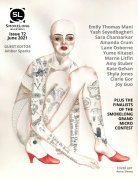I like to conceptualize the craft of setting as a matter of presenting possibilities to the reader. I love Quintland, as it immediately raises a set of alarming and exciting questions. With a bit of cursory Googling, I find Quintland is a real place. What drew you to write about Quintland, and does your writing often explore strange historical settings?
The cool thing about this story is that I wrote it in response to a Tweet from Amber Sparks and then she ended up guest editing this issue. The Tweet basically said that you should write about what you’re obsessed with. I thought, why haven’t I ever written about the quints? I was scary-obsessed with them when I was little. And this is back in the nineties when, if you wanted to learn about something, you had to get your parents to drive you to the library and search the card catalogue for books and ask the librarian to pull out microfilm. And if you had a specific question about the topic, you had to read the whole book to find the answer embedded on page 109. So I was eleven years old and reading books by Pierre Burton about the Great Depression because I was just that desperate to learn about the quints.
I’m often drawn to writing historical settings, though lately I don’t enjoy the research. Writing about the quints was a pure delight because I already knew pretty much everything about them. This story was basically mining my obsessive childhood brain. I was asking myself, what was so fascinating about the quints? Why was I jealous of them as a kid, even though I knew their story was tragic?
The dynamic layers you developed with this unreliable narrator in a small amount of space is incredible. Compounding the strangeness of Quintland, we have a narrator who enjoys the arts of lying and manipulation and may or may not be a disowned sixth sister. What I love here is that either possibility is complex and wild: If she’s a disowned sixth sister, it makes the reader question the nature of her family; if she’s a con-artist floating through a sinister delusion, there dread and curiosity in the question of what might happen next. How did these layers develop? Was this more intentional or more organic?
I think it was mostly organic. I was trying to write a narrator manifesting the obsession that I felt with the quints as a kid, but also the obsession that the general public felt. Reading about them, I often came across this idea of the “sixth sister.” Back then, it was common to say things like, “My daughter looks so much like them, she’s like a sixth quint heh heh.” And then the Dionne family also had another daughter, close in age, that they used to say that about. And I thought, there’s already five identical girls and it’s a miracle that they survived so why all this talk of a sixth? There’s almost something greedy about it. But that’s how obsession works. Eventually, you want to become one with the object of your obsession. These girls were so very studied, and doctors really did think there was a sixth, Cecile’s “twin” that died very early in utero. So my protagonist has latched onto that. And I thought, what kind of kid would tell herself that story to the extent that she’s going to hitchhike there to join them? And what kind of a household produces a kid like that? And how does a kid from that kind of household behave when she gets into a car with a nice, polite family?
At the core of the most interesting con artists, antiheroes, and antagonists is the tension between a drive to connect with others and also to correct an archetypal wrong; in their efforts to satisfy this tension, odd behavior and morally ambiguous, if not downright heinous actions can turn out to make quite a lot of sense, at least emotionally. What connection might this narrator seek? What wrong is she attempting to right?
It’s kind of a homecoming story. The protagonist sees herself as ousted from her family and denied her birthright (the Kingdom of Quintland, let’s say). Instead, she’s been living with this Delphina character and clearly not happy about it, doesn’t feel she really belongs there. It’s the classic, “I’m going to find my real family.” The scene at the end is meant to show the extent of her desire to belong. She recognizes something of herself in the other little girl, something so miniscule, and says, okay, you can come too. You can even be the seventh. We’ll go together. And I like that about the narrator. In her obsessive, delusional kingdom, there’s room for everyone.
Could you tell us more about The Church of Wrestling, your upcoming novella?
I would love to! It comes out June 15th with Split/Lip Press. It takes place in the nineties in Southern Ontario, centering around a girl wrestler and her dad. Like “Quintland,” it deals with obsession and a little delusion. It’s about how we fixate on particular moments, become haunted by them. It will be out in the world soon and I’m so excited.



 The SmokeLong Grand Micro Contest (The Mikey) is now an annual competition celebrating and compensating the best micro fiction and nonfiction online.
The SmokeLong Grand Micro Contest (The Mikey) is now an annual competition celebrating and compensating the best micro fiction and nonfiction online.